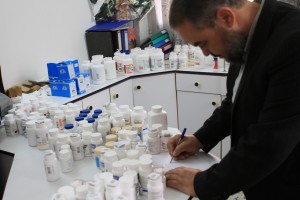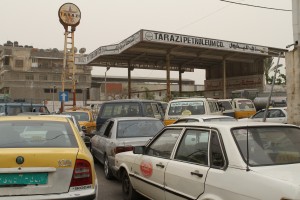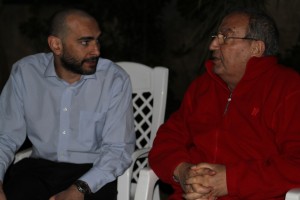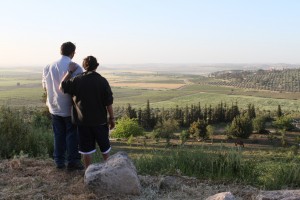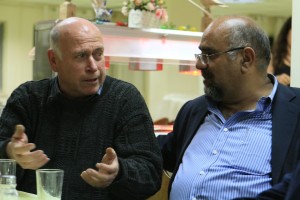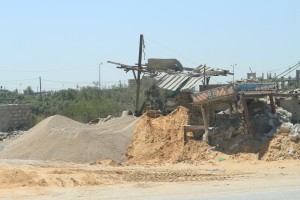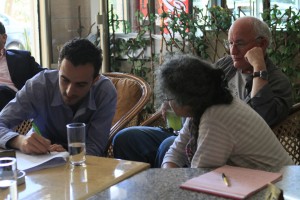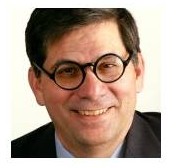(Gerri Haynes, a former president of Washington Physicians for Social Responsibility, is once again sending back reports from inside blockaded Gaza. As she did four times before, Gerri has organized a team of doctors and other health care providers to work in hospitals and clinics in Gaza in an effort to directly help the people there and to bring attention to the ongoing humanitarian crisis that the Israeli blockade has created. Second in the series.)
Rich Grady, Ismael Zamilpa, Laura Hart and Ahmed Abeid worked through the day in one of the local hospitals caring for children with surgical needs. The patients they cared for were pre-screened by local physicians and some have
waited for months to receive this care. The surgical schedule will be full for every operating day we are here.Gasoline is scarce. Long lines at the gas stations (stations that have been able to find a supply of gasoline – many stations are closed), stretch for blocks. We were told that people sometimes wait in line two or three days to put gas in their car and to get fuel for their home generators. Home generators carry their own dangers – air pollution, carbon monoxide poisoning, and explosive fire. We learned today of many children who have been burned in fires from generator accidents.
This evening, we were hosted for dinner by Dr. Eyad El Sarraj in the garden of his Gaza City home. Dr. Sarraj founded the Gaza Community Mental Health Programme – the program all mental health providers refer to in Gaza. The service provided and research done by this organization is known throughout the world for its standards of excellence and work done in this extremely difficult environment. WPSR delegates first met Dr. Sarraj during our 1993 visit to Gaza – he is an honored colleague and a mentor for all who seek peace.(Gerri Haynes, a former president of Washington Physicians for Social Responsibility, is once again sending back reports from inside blockaded Gaza. As she did four times before, Gerri has organized a team of doctors and other health care providers to work in hospitals and clinics in Gaza in an effort to directly help the people there and to bring attention to the ongoing humanitarian crisis that the Israeli blockade has created. First in the series.)
Travel from the U.S. to Gaza is arduous, but perhaps not as arduous as the travel from the West Bank to Neve Shalom – the place of peace guesthouse where our delegation spent our first night in this part of the world. Neve Shalom is run by Jewish, Christian and Muslim Israelis and sits on a hillside overlooking Latrun Monastery and the surrounding fields of crops, flowers, and beauty.
We were joined at Neve Shalom by Amos Givertz, an Israeli worker for peace and Zoughbi Zoughbi, with Lucas and Rafiq Zoughbi from Bethlehem. Amos drove to see us from his kibbutz near Tel Aviv. The Zoughbis, along with a visitor from France, came to us by hired car through the checkpoint from Bethlehem – a journey of constant challenges. Amos and Zoughbi Zoughbi, director of Wi’am (Palestinian Conflict Resolution Center) have known each other for decades and work together in spirit to achieve peace in this part of the world.
They spoke of the current situation in Israel/Palestine – with Amos giving vivid examples to support his belief that the Israeli government is not motivated by security needs, but by its goal of controlling the land. Amos’s work is specifically focused on the Bedouins in the Negev Desert. He regularly publishes his findings in a report titled, Don’t Say We Didn’t Know.This morning, we were driven to Erez Checkpoint – the only passage for people hoping to enter or leave the Gaza Strip from the north. Our passing through Erez requires weeks of preparation – applications, explanations, sponsorship – extensive communication. Permission to cross must be granted by Israel and by the Hamas government in Gaza.
For us, the crossing takes time and patience, but for Palestinians, the crossing is rarely allowed. Today, we saw mostly foreign journalists and UN workers – with a few Gazans coming toward Israel for medical care. Permission to leave Gaza to receive types of medical care that is not available in Gaza requires arduous and often unsuccessful processing. Most Palestinians who leave Gaza generally travel through the southern checkpoint into Egypt – and even this takes time and complex processing and often meets with denial.
And now we are here!! This is the fifth medical service delegation to visit Gaza from Washington Physicians for Social Responsibility – we are eleven in number and the work of some of our physicians has already begun. Two pediatric urologists, Rich Grady and Ismael Zamilpa and one adult urologist, Laura Hart, are screening patients for surgery in the days ahead.We were to stay in Gaza until April 25, but on entry, we were told that the Erez checkpoint will be closed from April 25 – April 29, due to the Israeli Independence holiday and regular weekend closure.
We will leave on April 24 and visit the West Bank.There are fewer cars on the roads in Gaza now than during our last visit in October 2011 – fuel is in short supply and expensive. Electricity remains an on-again-off-again commodity – affecting everything from food and medicine storage to communications. And still the people we meet are gracious and generous of spirit – wanting the freedom to work and raise their families in peace.
Many people contributed generously to the purchase of medicines for us to bring as donations to patient care in Gaza. People contributed toys, school supplies, sporting equipment and gifts. Two of my grandchildren sorted carefully through their toys and found treasures to send – toys they described as still ‘sparkly.’ All these gifts from the hearts of people in the U.S. who want the people of Gaza to know in some way that they are not forgotten.
(Seattle activist Bert Sacks defied the draconian sanctions against Iraq, for which the U.S. government fined him $10,000. Sacks refused to pay despite years of government threats and court actions.)
But first … a book review.
Every once in a while an experiment is done which changes fundamentally how we look at the world. The Michelson-Morley experiment in physics, 125 years ago, changed how we understood the nature of light – and provided support for a paper Albert Einstein was to publish eighteen years later. Einstein’s ‘thought experiment’ – his Theory of Special Relativity – radically changed our world.
His insight into physical nature led Einstein to recognize the equivalence of mass and energy, stated in the famous equation e=mc2. And this led to the eventual development of the atomic bomb.
In the year following publication of Einstein’s theory, another experiment was done by a man who would become no less famous than Einstein and who would also provide insight into a different source of energy, a radically constructive and healing energy within human beings. The date was September 11, 1906 – the man was Mohandas Gandhi – and the energy he discovered on that date he came to call satyagraha or “truth-force.”
The common English translation of these terms is “nonviolence.” But that word is often taken to connote a negative – even when not hyphenated – meaning simply not physically violent, or not assertive, not confrontational. However in 1906 Gandhi began to develop this force until it became so powerful as to cause the British Empire to leave its prize colony India.
A new book by Jim Douglass provides a fascinating and detailed story of Gandhi’s own development of this force, which he used to lead India to independence. It is called Gandhi and the Unspeakable: his final experiment with truth. If it were only an account of Gandhi and nonviolence, it would be well worth reading.
But it is significantly more. It is also the story of an opposing force – a force diametrically opposed to the power of nonviolence which Gandhi advocated – a force which was to lead to Gandhi’s assassination – and which would lead India eventually to develop a nuclear bomb.
This book is about events many decades ago. But few books are as relevant now to our world situation. Today our leaders are debating whether to attack Iran because they may be wishing to have what nine other nations in the world already possess, an atomic bomb.
This book about Gandhi begins with a quote from him: “I did not move a muscle when I first heard that the atom bomb had wiped out Hiroshima. On the contrary, I said to myself, ‘Unless now the world adopts nonviolence, it will spell certain suicide for humanity.’” The book ends with this quote from Martin Luther King: “The choice today is … either nonviolence or nonexistence.” That choice is ours.
We barely averted nuclear holocaust during the Cuban missile crisis, when John Kennedy had to call on Nikita Khrushchev for help to resist our own military, which was pushing him for a first-strike nuclear attack on the Soviet Union. And Khrushchev had to resist the push of his own military to attack us as well. This fascinating account of Kennedy’s turn towards peace is documented in Jim Douglass’ earlier book JFK and the Unspeakable: why he died and why it matters. That book argues that Kennedy was assassinated by a dark force aligned with violence, just as Gandhi was killed by a similar dark force.
That dark force is “The Unspeakable” in the title of both books. It is a phrase from the Trappist monk Thomas Merton. Merton characterizes it this way:
It is a void that contradicts everything that is spoken even before the words are said; the void that gets into the language of public and official declarations at the very moment when they are pronounced, and makes them ring dead with the hollowness of the abyss. It is the void out of which Eichmann drew the punctilious exactitude of his obedience.
I thought of this description when I listened to President Obama’s opening statement in his 2012 State of the Union address:
Last month, I went to Andrews Air Force Base and welcomed home some of our last troops to serve in Iraq. Together, we offered a final, proud salute to the colors under which more than a million of our fellow citizens fought – and several thousand gave their lives.
We gather tonight knowing that this generation of heroes has made the United States safer and more respected around the world.
Can anyone possibly believe that our 2003 invasion and war in Iraq has “made the United States safer and more respected around the world”? Can President Obama possibly believe this? Does it matter that thousands of U.S. lives were lost, hundreds of thousands of Iraqi lives, $5 trillion dollars have or will be spent paying for the war, Iraq has been left in shambles, and much of the world knows about Abu Ghraib and knows that this war was an illegal war of aggression? Does it matter that no one can believe what Obama says?!
This is “The Unspeakable” made palpable in words – words that no one pays attention to – and which therefor become especially dangerous and lethal as they seep unnoticed into our consciousness. It is “the void which makes [official declarations] ring dead with the hollowness of the abyss.”
Gandhi has said that Western civilization is a civilization of violence. If we continue with our reliance on violence – spending half the world’s total outlays for war preparation – we are practicing a form of financial bankruptcy. And the implicit idea that we can a prevent nuclear war (or nuclear accident) by attacking countries we decide are untrustworthy of the bomb is absurd. For how long? For another decade? For another generation? What about our grandchildren? What about nuclear abolition?
The power of Gandhi and the Unspeakable is that Jim Douglass has posed the choice we confront today in stark terms of two opposing world views – views dramatized in the lives of these two central protagonists in the struggle to decide how India should win its independence. One is Gandhi, a man so well known that he is often referred to simply as “The Mahatma” (The Great Soul); his means was nonviolence. The other is a man virtually unknown outside of India, Vinayak Damodar Savarkar, the dark mastermind behind Gandhi’s assassination; his means were assassination, terrorism, violence.
In 1909, when Gandhi was on a visit from South Africa to London, he shared a speakers’ platform with Savarkar to debate their respective understandings of how to free India. Gandhi repeatedly stressed the inherent, inviolate connection between the means with the end. Gandhi said that no good end can be achieved with bad means. If you kill to achieve a free India you will create a state ruled by violence.
Albert Einstein is reported to have said, “The atomic bomb has changed everything except our way of thinking.” Mohandas K. Gandhi taught us a different way of thinking. James W. Douglass has put that new way of thinking in sharp contrast with the old – the old way that we, especially in America, have become so accustomed to accepting that we no longer think about it.
Gandhi also said that “Truth is God!” It is our choice between nonviolence – what Gandhi called “holding to truth” or satyagraha – and violence, nuclear war, and living our lives within an unarticulated knowledge of the Unspeakable. Gandhi could also have said, truth is good. If we have the courage to seek to know deeply what is true … and to hold to that truth as best we know it.
The process of seeking to know what is true, and holding to truth in action, Gandhi called his experiments with truth (the subtitle of his autobiography). I believe we all in our lives conduct our own experiments with truth, however small and subtle they may seem. And whatever is the outcome “out there” they will all have an impact on our lives “on the inside.”
Sixteen years ago, Jim Douglass came to Seattle and spoke about his travel to Iraq a few months earlier. He spoke about what he witnessed in that country, devastated by the Gulf War and sanctions. I thought to myself, if this is the kind of person who goes on this kind of delegation perhaps I should consider it for myself. And so thus began my own experiment with truth, confronting the unspeakable in American foreign policy towards the people of Iraq.
Now it seems my legal confrontation with the U.S. government over Iraq has at last come to an end. I had planned to write something of what I’ve learned from the experience. But the end of my case has come just a few days ago. And I’ve written quite enough for one posting already. I’d also like time to formulate my thoughts about the benefits of doing what I’ve done: activism as a tool for coming to truth.
That said, there are a few final things I want to say today: I need to express my deep gratitude to my lawyers who’ve given so generously and freely of their time. And to express my appreciation for all of those who’ve read these postings and followed my case with their words of support. And finally to my friends in the media who’ve recognized that this issue is not ‘old news’ but an important ongoing one.
Thanks to you all,
Bert
Usually the entire civilian population, including women and children, pay a large price and take the brunt of this situation.
Our concern is the lack of medication and supplies, and if the operation continues, the number of causalities will increase; currently the toll is 16 dead and 30 injured.
The Gaza Population already lives under a devastating humanitarian situation, while the occupation continues, and the internal conflict is not solved, and the governments of the world are silent. And indifferent.
We at the RCSG, appeal to the international community, and to our friends and supporters, to spread the word, bring pressure on your governments, and stop these attacks soon.
The humanitarian situation in Gaza is on the verge of collapse as the military attacks continue, while we lack electricity, and our medical facilities and hospitals have exhausted their fuel to operate the alternative generators.
We have insufficient medication – 186 basic medications are lacking in our pharmacies and drug stores, and in addition to the insufficient medical supplies, children in the special care baby units are in great danger. Renal dialysis patients and cancer patients are dying unnecessary, while unable to have their treatment, diabetic and asthmatic patients, as well as many chronic illness patients, those who need their medications regularly but cannot get them. The list is too long to mention.
Please act immediately to stop this attack against the Gaza population.
You have been always great supporters and showed your solidarity, at the most difficult times.
Yours sincerely,
Mona ElFarra
Vice president
Red Crescent society for Gaza strip
MECA Director –Gaza Strip
Mona4gaza@yahoo.com
0097-0598868222
By Mark Trahant
(Mark Trahant is a writer, speaker and Twitter poet. He is a member of the Shoshone-Bannock Tribes and lives in Fort Hall, Idaho. You can reach him through www.marktrahant.com. His new book is “The Last Great Battle of the Indian Wars,” the story of Sen. Henry Jackson and Forrest Gerard. The following is used thanks to Crosscut.com under a Creative Commons license.)
Could the continuing back-and-forth over contraception as an insurance benefit actually be an opportunity for consensus? Consider this outrageous idea: Neither government nor our employer ought to be responsible for our health care decisions.
We can make our own, thank you.
That idea, though, would mean reversing the country’s biggest health care mistake, basing our insurance coverage on our jobs.
Less than two-thirds of all workers now have access to employer-based health care and that number has been in decline, especially for lower-income workers. Already small businesses are less likely to offer such plans and increasing insurance costs are clearly a competitive drag on business. General Motors spends roughly $5 billion covering more than a million employees and former employees.
The U.S. Chamber of Commerce calls health care the most expensive benefit paid by employers. One study by the Rand Corporation found that companies providing generous health care benefits grew less than their competitors in Canada, where the government pays for that health care.
But it’s not just the money. The amount of time a company spends on judging insurance plans, negotiating rates, and informing employees about changes every year, could be better spent on just about anything else. And from the employee point of view, we don’t get a lot of choice about what kind of health care plan we want.
The insurance menu is limited by the employer. (Talk about changing doctors: When a company changes carriers, it’s goodbye to the family practice where you’ve been going for years.) And that doesn’t even account for the many Americans who are tied to a job only because of a company’s health care benefit.
The conservative message should be clear. If you believe in a market-based system, then the individual, not the company (or a church organization), should be making decisions about their own health care needs.
Democrats have been clinging to the current system, in part, because labor unions have fought so hard to win health care benefits for workers. Giving up those employee benefits now would seem like a retreat. But the nature of work is changing. More of us work at home and some of us are even excited about the prospect of buying our own plan on the open market when the insurance exchanges begin in 2014.
How do you make the practical transition away from an employer-based system? Here is one idea: Give corporate America incentives and a deadline on when health benefits will no longer be eligible for a tax deduction. Then, as a transition, pick a year where every employee in America gets a “raise” equal to the amount that’s already paid in health care benefits. From then on health insurance would be an individual purchase, not an employment benefit.
The Affordable Care Act already provides a mechanism for health care insurance for lower-income Americans, so this could be the plan for everybody else.
Extricating ourselves from a historical mistake is a simply a problem to be solved. Shifting insurance to the individual could lift a burden from corporate America — and make it easier for all of us to buy health insurance at a reasonable price. Then we the consumers would have the power to pick contraception or any other benefit we think important without oversight
from either our boss or the government. We’d be free to choose.
(The writer was a Kaiser Family Foundation fellow on health care reform during much of the debate on the Affordable Care Act. “Beyond birth control: How everyone could choose on health care” by Mark Trahant/Crosscut.com is licensed under a Creative Commons Attribution-NoDerivs 3.0 Unported License.)
This is used with permission of Intercontinental Cry, an all-volunteer online journal founded in 2004 and dedicated to providing reports, videos and action alerts on the most pressing Indigenous struggles.
February 10, 2012
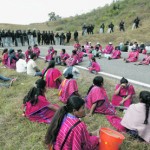 The Triqui people of San Juan Copala are returning to the Palace of Governance in Oaxaca de Juárez after a series of shameful moves by the Oaxaca government.
The Triqui people of San Juan Copala are returning to the Palace of Governance in Oaxaca de Juárez after a series of shameful moves by the Oaxaca government.
Things were finally starting to look up for the displaced community. On January 23rd, 2012, Oaxaca Governor Gabino Cué agreed to send an armed escort to accompany the Triqui on their return home after being displaced by paramilitary groups 16 months ago.
But then, Governor Cue presented a Peace Accord with some last minute revisions that Triqui representatives dared not accept.
Under the terms of the Accord – which would supposedly guarantee the Triqui’s safety – just 5 families per week would have been be allowed to return home instead of everybody at once. Presumably, those 5 families would have also needed to travel without any escorts, be they police officers, human rights observers or government officials. The paramilitaries used such conditions before, to terrorize the Triqui People.
The Triqui ultimately decided to proceed with their Caravan, without a police escort.
The journey was going good at first. But then, after a day’s journey along the highway to San Juan Copala, the caravan came face to face a with a police blockade.
The paramilitaries set up their own blockades along the highway too. They also occupied San Juan Copala–and not in the way that some of us can feel good about!
Things went downhill from there. Government officials who showed up at the blockade later on, asked the Triqui to sit down and “negotiate” with the paramilitaries.
Then came the arbitrary arrest of a member of the caravan, which was followed by the sudden suspension of talks and the complete withdrawal of all police and government officials from the area, practically leaving the caravan to the paramilitaries.
Sufficed to say, the Triqui have been once again betrayed by the Oaxaca government.
Nevertheless, the The autonomous Triqui community of San Juan Copala has no intention of simply giving up; not with so much at stake.
More Information
FEB 9: San Juan Copala: Autonomous Triquis want to go home
FEB 1: Displaced Triqui women to enter Copala
JAN 30: The Caravan of the Displaced Returns to Yosoyuxi
JAN 29: Communiqué of the Community Council of the Municipio Autónomo de San Juan Copala
JAN 29: State officials break off dialogue with arrest of David Venegas. Call for a new caravan
JAN 28: MULT Paramilitaries occupy San Juan Copala and maintain road blocks to prevent the return of the Displaced
JAN 27: Police stop the caravan of the displaced from San Juan Copala
JAN 27: Triqui Caravan Departs to San Juan Copala, Oaxaca, Mexico
JAN 26: Triquis displaced from San Juan Copala say Caravan will go ahead
JAN 26: We hold Gabino Cué, MULT and UBISORT responsible for what may happen to us in San Juan Copala
2011
SEP 29: Displaced women from San Juan Copala forced to suspend peaceful sit-in
2010
SEP 24: Authorities Order Total Evacuation of San Juan Copala, Oaxaca
SEP 9: Unending Violence for the Indigenous People of San Juan Copala
2007
JAN 28: The Triquis Inaugurate Their New Autonomous Municipality
More news and updates are available in Spanish at http://municipioautonomodesanjuancopala.wordpress.com
BY MARK TRAHANT
Presidents are required to be optimistic.The American people expect it — and reward those politicians who know their lines. President Barack Obama’s State of the Union Tuesday night followed The Script (so much so that Republicans released a video dismissing the president’s consistent rhetoric as more of the same).
“The state of our Union is getting stronger. And we’ve come too far to turn back now,” the president said. He promised “to fight obstruction with action, and I will oppose any effort to return to the very same policies that brought on this economic crisis in the first place.”
The president said the “defining issue of our time is how to keep that promise alive … no debate is more important.”
That is the rub. That is where the president’s optimism hits the side wall in a country divided. One side of our body politic is consumed by a deep distrust of anything that smacks of government, even when government actions are in our best interest.
We need to make the case for government investment. Putting money into programs and policies that will reward society. I would put education at the top of that list.
We have, as a nation, a demographic advantage over many other nations. The United States has a higher fertility rate than that of Russia, Germany, Japan and well above that of China, Italy, Singapore and most of eastern Europe. We have a young, growing working population.
But to execute that advantage we need to do improve higher education.
At the very moment we need a better educated work force, we are making it more difficult for young people to succeed in college. As the president put it: “When kids do graduate, the most daunting challenge can be the cost of college. At a time when Americans owe more in tuition debt than credit card debt.”
This is a crippling problem for young people. Just over a year ago when I was on my Kaiser Family Foundation fellowship I talked to medical professionals — doctors, dentists and nurses — who said the type of practice they were planning was dictated my their debt load. I heard many young doctors talk about what it was like to owe hundreds of thousands of dollars. I’d like to see more loan forgiveness programs, focusing on the areas of health need such as rural medicine.
The president called on Congress to limit interest rates on student loans, increase student aid and work-study. He also asked states to make education a higher priority in their budgets. I love that idea … but it shows the complexity of these problems. States cannot add more money into education until the country reduces its health care spending.
The president talked about restoring a manufacturing sector in this country. I suppose that could happen, only on a limited scale. But I don’t think we are ever going to have the type of factories and jobs that once built our middle class. But we can have a nation that, on the whole, is more creative, better educated and prepared for the challenges ahead.
But before any of this happens we have to get over this notion that all government spending is bad. It’s time to invest in young people.
Mark Trahant is a writer, speaker and Twitter poet. He is a member of the Shoshone-Bannock Tribes and lives in Fort Hall, Idaho. Trahant’s recent book, “The Last Great Battle of the Indian Wars,” is the story of Sen. Henry Jackson and Forrest Gerard.
 (Press release from Seattle Mideast Awareness Campaign, an all-volunteer organization incorporated in Washington State. For more information: www.SeaMAC.org)
(Press release from Seattle Mideast Awareness Campaign, an all-volunteer organization incorporated in Washington State. For more information: www.SeaMAC.org)
This just in from SeaMac:
FOR IMMEDIATE RELEASE
12/28/2011
Contact: press@SeaMAC.org
Carla Curio (206) 450-0706
Peter Lippman (206) 285-2154
SEAMAC BRINGS BACK ISRAELI WAR CRIMES AD
Seattle Mideast Awareness Campaign (SeaMAC) will publish a large ad with the slogan ISRAELI WAR CRIMES: YOUR TAX DOLLARS AT WORK on December 28 in both The Stranger and Seattle Weekly. The ad commemorates Israel’s assault on Gaza in December 2008, as well as the censoring of SeaMAC’s “Israeli War Crimes” bus ad last year by King County Metro.
The half-page ad will run for two weeks in each newspaper. The ad repeats the slogan and design of SeaMAC’s bus ad that was censored by King County Metro last year.
The dates of the bus ad last year and the newspaper ads this year were chosen to observe the anniversary of Israel’s three week military offensive against the captive population of Gaza which began on December 27, 2008, and resulted in the deaths of more than 1,400 Palestinians — most of them non-combatants and more than 300 of them children. The language of the ad is based on investigations by Amnesty International, the United Nations, and other human rights groups, which found evidence of war crimes committed by Israel during the assault on Gaza. Numerous other war crimes by Israel have been documented during the long occupation of the West Bank and Gaza. The ads also draw attention to the $30 billion promised to the Israeli military by the U.S. government over a 10-year period, which is part of the U.S. government’s one-sided financial, military, diplomatic, and political support for Israel.
King County first approved and then censored SeaMAC’s bus ad on December 23, 2010. King County Metro then twice revised its advertising policy to prevent any “public issue advertising expressing or advocating an opinion, position or viewpoint on matters of public debate about economic, political, religious or social issues”. In spite of that policy, King County Metro has since accepted advertisements for the Mormon religion and a labor rally, as well as a recent ad that said “Buy American”.
“It’s hard to see how King County has been unbiased or ‘viewpoint neutral’ when they have continued to run other political and religious advertisements while censoring ours,” said SeaMAC volunteer Edward Mast.
The American Civil Liberties Union (ACLU) of Washington is representing SeaMAC in a lawsuit against King County for breach of contract and for violating SeaMAC’s First Amendment right of free expression. The trial was scheduled to begin in federal court on October 31. King County lawyers filed a motion to dismiss the lawsuit, and a federal judge granted King County’s motion on October 10. SeaMAC has filed an appeal with the federal Ninth Circuit Court of Appeals.
Another SeaMAC ad, with the slogan EQUAL RIGHTS FOR PALESTINIANS, was accepted and put up on billboards in April 2010 by Clear Channel Outdoor, a private firm. Clear Channel then censored SeaMAC’s ads. Clear Channel had also run other controversial ads which caused public outcry, including an ad that advocated laboratory testing on live animals.
“Why should criticism of Israel be singled out for silencing?” says Peter Lippman, another SeaMAC volunteer.
SeaMAC’s print ads about Israeli war crimes are part of a series that began last August in Seattle Weekly and The Stranger. The ongoing series draws attention to Israel’s policies of segregation and apartheid, as well as the treatment of Palestinian child prisoners and Israel’s attempt to impose a non-viable fake state on Palestinians living under Israel’s illegal military occupation.
SeaMAC’s complete series of print ads can be viewed at SeaMac.
This just in from Intercontinental Cry, an all-volunteer online journal founded in 2004 and dedicated to providing reports, videos and action alerts on the most pressing Indigenous struggles.
The Latin America Mining Monitoring Programme is organizing an Open Letter to Peruvian President Ollanta Humala regarding the recent shootings of protesters in the region of Cajamarca, Peru.
As documented in the following video by LAMMP, some 10,000 people had been gathered near the proposed Conga gold mine when police opened fire on the unarmed crowd, injuring up to 18 people.
Following the attack, the government of Peru denied that any bullets were fired. Then, on December 4, it declared sixty days of martial law in the region, suspending basic civil liberties and allowing security forces to break up meetings and arrest protesters at will.
Despite the aggressive measures by Peru, the mostly Indigenous protesters have vowed to continue pursuing their non-violent opposition to the mine.
Please take action now by joining the Open Letter to President Humala of Peru pasted below. Please write to info@lammp.org to add you name to the current list of signatories:
Open Letter to President Humala
President Ollanta Humala Tasso
Despacho Presidential
Jiron de la Union s/n 1 cdra
Lima
Peru
We, the undersigned individuals and institutions of several continents, committed to the movements for world justice, environmental protection and sustainable development, write to express to our deepest concern regarding events currently unfolding at the Yanacocha mine in Peru, owned by US company Newmont, with participation of the World Bank.
On 24 November tens of thousands of Peruvian citizens initiated a protest against the development of the Yanacocha mine at the Conga site. The protesters claim current plans for the mine will destroy the surrounding environment and fresh water supplies affecting a population of approximately 100 000.
On 27 November a report produced by the environment minister Mr Ricardo Giesecke identified severe failings in the Environmental Impact Assessment (EIA) approved by the previous administration in relation to the Conga site. We understand Mr Ramiro del Pino, responsible for the government department which approved the EIA, was a former executive of the Yanacocha mining company. Despite these shortcomings and appearance of impropriety, the government of Mr Humala has not sought to review the mine plans and has dispatched security forces to the Conga site.
On 29 November the security forces opened fire on unarmed protesters approaching mine installations. Up to 18 protesters reportedly received gun shot wounds. Between 8 and 30 policemen were injured. The government has so far failed to admit the extent of the civilian casualties and the use of live ammunition. Following the shooting the Yanacocha mine announced it would suspend its operations.
On 4 December the government declared sixty days of martial law or “state of emergency” in the region of Cajamarca. This measure suspends civil liberties and allows security forces to break up meetings and arrest protesters at will. On 6 December Mr Wilfredo Saavedra and five other protest leaders were detained without warrant or charges being laid. Protesters have vowed to pursue peaceful opposition to the mine.
The above situation has created an imminent risk of large scale violence. The circumstances bear a distressing resemblance to the string of recent incidents surrounding extractive industry protests, including the Bagua shootings of June 2006 in which at least 34 protesters and police officers were killed. Such conflicts ultimately entrench antagonisms and frustrate the interests of all concerned.
As the world follows the events at the Yanacocha mine in the following days, we respectfully urge you Mr Humala to consider the following measures: 1) to honor Peru’s commitments to the rule of law and human rights by recognizing and compensating the victims of the 29 November shootings 2) to guarantee the ongoing physical safety of protesters in the Cajamarca region including the right to justice and humane treatment upon detention 3) to properly address environmental concerns raised by the Conga mine and enforce corresponding requirements on the Yanacocha company.
BY MARK TRAHANT
(Mark Trahant is a writer, speaker and Twitter poet. He is a member of the Shoshone-Bannock Tribes and lives in Fort Hall, Idaho. Trahant’s recent book, “The Last Great Battle of the Indian Wars,” is the story of Sen. Henry Jackson and Forrest Gerard.)
I wrote at the time: “When President Obama reached the podium at the Interior Department last week nearly every person in a seat lifted a cell phone to take a picture. Row after row of glowing screens captured that moment. But that photo-op is no longer enough. A year ago it was a big deal to meet. But a year from now it will only be a big deal if there are success stories that add jobs, improve the health or educational opportunities for young Native Americans.”
Here we go again. Tribal leaders are in Washington this week for a variety of meetings including the White House Tribal Nations Conference.
But the Big Deal is not there. There are fewer success stories in Indian Country than a year ago. We can’t point out new jobs, a better health care system or increased educational opportunities. In fact as the federal budget crunch hits, all of these indicators will trend worse.
But President Obama is not the problem. The real Big Deal is that Washington is going through a government-wide transformation and the president has limited power to either shape or stop the radical redesign of all-things-federal. But the president is not alone. The Republicans in Congress also have limits. As do the Democrats. That means there is no clarity in how to proceed — and the debate goes on and on without resolution.
But the policy of contraction — the shrinking of the federal government — is set to occur no matter what.
The failure of the supercommittee requires automatic budget cuts to begin in 2013. There will be no room for discussion about which programs work (or don’t) because the budget will be slashed by blind percentages. (The only plus: At least it’s a year away.)
This month Congress will fight over a temporary budget. One of those limits of power: Neither side has the votes to enact a traditional budget. So the government is funded by a Continuing Resolution, one that expires December 16. Congress will have to vote to extend that date or shut down the government. Again.
A great example of the deep divide is the impact of government spending. Republicans have been saying for months that the American Recovery and Reinvestment Act of 2009 did not work because we still have high unemployment. But the Congressional Budget Office released estimates that counter that claim. CBO said unemployment was at least .2 to as much as 1.3 percent lower because of the stimulus funding. It also said the federal spending was a net positive addition to the economy. (A study last year by the National Congress of American Indians highlighted nine examples of how the act worked in Indian Country.) But the data won’t change any minds. Those that believe government is essentially evil will continue to press for less.
Taxes will continue to be another dividing line — especially over the next few days and weeks. The Bush income tax cuts expire at the end of the year unless Congress does something to extend those rates. By the same measure, payroll tax cuts and unemployment benefits must be extended by the end of the year. Most of us pay more in payroll taxes than we do in income taxes. The Republicans tend to favor income tax cuts and Democrats will back extending payroll tax cuts and longer unemployment benefits. This is important because neither side has the votes to do anything on its own. So the likely choice is both or none.
Ideally, both in the Congress and at the White House meeting, there will be a transition plan put into place for Indian Country before the 2013 budget cuts. That plan could include flexibility in how federal dollars are spent, transition funding to make the coming cuts less painful, or perhaps, even, trying a few new ideas.
Then, a year from now there might not be new Indian Country success stories to swap. But at least there will have been an effort to prevent tragedy.
